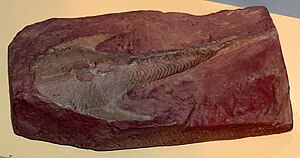Cephalaspis
| Cephalaspis | ||||||||||
|---|---|---|---|---|---|---|---|---|---|---|

Fossil of Cephalaspis in the Düsseldorf Aquazoo - Löbbecke Museum |
||||||||||
| Temporal occurrence | ||||||||||
| Lower Devon | ||||||||||
| 418.1 to 391.9 million years | ||||||||||
| Locations | ||||||||||
| Systematics | ||||||||||
|
||||||||||
| Scientific name | ||||||||||
| Cephalaspis | ||||||||||
| Agassiz , 1835 |
Cephalaspis is a genus of Osteostraci , an extinct group of jawless fish , from the Lower Devonian (418.1 to 391.9 mya ), which is known from the freshwaterdepositsof the Palaeozoic continent of Euramerica (also: Laurussia, "Old Red Continent").
features

This fish had a large, bony head shield and an only lightly armored abdomen. On the top of the head shield, the two eye openings are very close together, another opening between the eyes may have housed another light-sensitive organ. A little in front of it, on the midline, was the keyhole-shaped nasal and pituitary opening. In depressions in the head shield, one teardrop-shaped behind the nasal and pituitary opening and two arched ones on the edge of the head shield, there were scaly fields that could also be used for sensory perception. It is possible that they reacted to pressure fluctuations in the water in the same way as the lateral line organ of today's fish or could perceive electrical fields. In arched indentations on the rear edge of the head shield there were two pectoral fins and on the outside each a pointed spine pointing backwards. On the underside of the head shield was the mouth in front, behind it a wide, scaly surface. The nine to ten gills were on the side.
Inside the head shield, the Swedish paleontologist Erik Stenisö was able to identify the brain, nerves, eyes, the inner ear with the organ of equilibrium and parts of the digestive system . The brain, like today's fish, consisted of medulla , pons and telencephalon .
Way of life
Fossils of cephalaspis found in freshwater sediments and sediments of river deltas and coastal lakes. The fish obviously lived on the bottom of the water and fed on detritus, moving their semicircular head back and forth . The strong abdomen suggests that Cephalaspis could cover longer distances in open water. Buoyancy was created by the shape of the head shield and the pectoral fins.
literature
- Michael J. Benton : The biology of the Cephalaspidomorphi. In: Michael J. Benton: Paleontology of the vertebrates. Friedrich Pfeil Verlag, 2007, ISBN 3899370724 , pp. 64–65.
Web links
- The Paleobiology Database Cephalaspis
